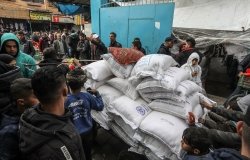Temporary Migrant Careworker Programs in Canada and the European Union: Models for the United States?
What are appropriate policy models for migrant carework programs in the United States? Panelists discussed the impact of migrant labor on families in their countries of origin and the legal and regulatory challenges to reforming the migrant carework system.
Overview
Monica Boyd, Chair of the International Migration section of the American Sociological Association
Xóchitl Castañeda, Director of Health Initiative of the Americas at the School of Public Health, University of California Berkeley
Muzaffar Chishti, Migration Policy Institute
Helma Lutz, Professor, Goethe University, Frankfurt
Margie McHugh, Migration Policy Institute
Sonya Michel, Senior Scholar, Professor of History, University of Maryland, College Park
Kimberly Morgan, Professor, George Washington University
Leticia Robles-Silva, University of Guadalajara, Mexico
Tamara Woroby, Professor, Johns Hopkins University (SAIS- School of Advanced International Studies) and Towson University (College of Business and Economics)
With an aging population and high rates of female labor force participation, the United States is facing an acute shortage of caregivers for children, the elderly, and those with chronic conditions. As they have in many other fields, migrants from near and far have recognized this demand and now make up at least 25 percent of personal caregivers in the United States. The United States is no different from other developed societies in attracting migrants to work as caregivers, but other countries have responded differently. In order to explore some of these differences, United States Studies, in cooperation with the Center’s Canada and Mexico Institutes, hosted a conference to analyze migrant carework programs in Canada and Europe and consider whether they might serve as models for future U.S. policy. The panelists also discussed the impact of migrant labor on families in their countries of origin, as well as the legal and regulatory challenges to reform.
The opening panel, moderated by Tamara Woroby, offered an overview of carework programs, both formal and informal, in Canada and German-speaking Europe. Monica Boyd described how carework migration in Canada may be characterized both literally and figuratively as “entering through the backdoor.” After tracing the history of Canadian migration policy, Boyd outlined several problems facing migrant careworkers. Under the Live-in Caregiver Program, she said, individuals gain eligibility for permanent status after working as domestic employee for 24 months in a three-year period. This “backdoor” has meant that individuals trained as engineers, nurses, and teachers are now taking carework jobs as a path to legal residency, resulting in pronounced deskilling and making future professional employment difficult. Although migrants are admitted to Canada by federal immigration authorities, labor laws are determined by the provinces, creating a web of regulations and making reform more difficult.
Speaking from a European perspective, Helma Lutz provided insight into home-based carework in Austria and Germany. While strong demand for careworkers has developed in these two countries over the last fifteen years, there is, according to Lutz, “political ignorance of the deficit” in care. German-speaking Europe has strong social policies, including work flexibility and kindergartens to provide care for the children of wage-earning mothers, but restrictive migration policies have resulted in “an irregular market for migrant carework.” Unlike Canada, neither Germany nor Austria has dedicated carework schemes, with the result that such work is mostly undertaken on an informal basis, without contracts. Germany does, however, pay care allowances to family members of the elderly for home care, money that is often “outsourced” to migrant workers when family members are themselves employed full-time.
Looking at carework from the perspective of migrants and their families, the second panel, moderated by Kimberly Morgan, addressed the impact of migration on their own care needs. Leticia Robles-Silva presented two ethnographic studies of Mexican families in Guadalajara from 1997 to the present, drawing several conclusions about the effects of cross-border care. She found that access to quality care, especially for the elderly, depends on the financial resources available to pay for private physicians. In order to afford these expenses, families are forced to rely on remittances from children living and working in the United States. Migrant children also provide caregiving from a distance through the emotional support of telephone calls, and they attend to care responsibilities during visits home, also enabled by earnings in the United States. The care scenario is different for each generation and among different social classes, Robles-Silva noted. The sense of responsibility is greater for first-generation migrants, and is expressed in more practical terms by daughters than by sons.
Expanding the topic of care to the migrants themselves, Xóchitl Castañeda contended that many migrants in the United States lack access to even the most basic forms of health care. As with the wider population, the health of migrants depends on several social factors, including status, race, and geographic isolation. It is especially difficult for migrants with little education or English proficiency, Castañeda argued, to navigate the complexities of local, state, and federal health programs. As “the gatekeeper to healthcare system in the United States,” she said that health insurance acts as a barrier to proper care, particularly since many migrants work in the informal economy and thus do not receive insurance benefits through their employers. “The health of a country is also the health of its immigrants,” Castañeda declared, challenging the audience to think about the broader public health impact of poor migrant health on the general population.
The conference’s final panel, moderated by Sonya Michel, considered the implications of the Canadian and European models for U.S. policy. Muzaffar Chishti noted that the country’s policy on carework migration is not only incoherent but virtually nonexistent —a fact of deep concern in light of the aging baby boom generation. Over the last two decades, several half-hearted attempts have been made to address nursing shortages, but, he said, these have fallen short “both in respect to the supply of foreign workers and in meeting the labor needs in our own country.” Today, large numbers of care workers in the United States are foreign-born, despite the lack of comprehensive policy for their entry into the country. This means that much of the demand for such workers is being met illegally. Concluding on an optimistic note, Chishti cited domestic workers’ successful attempts to organize across the country, as well as the landmark domestic workers rights legislation passed in New York State, which ensures a standardized work schedule and guaranteed days off.
Margie McHugh concluded the presentations by providing a realistic assessment of what can be expected of immigration reform efforts in the United States. The need for comprehensive immigration reform, she said, has resulted from the presence of such a large undocumented population already living here. The demand for careworkers, among others, has turned the United States into a “job magnet for immigrants,” but this is out of synch with the immigration system. Because of country caps and the low number of visas available for unskilled workers (only 5000 per year), along with backlogs of family members waiting to join those already here, many undocumented migrants feel they have a “legal basis on which to immigrate” while waiting to receive formal authorization to do so. While the need for reform is widely acknowledged, disagreements persist on key elements of a comprehensive solution. The lack of Congressional support for wholesale reform led McHugh to speculate that piecemeal measures, perhaps at the state level, may be the best route to progress in the near term.
By: Andrew Bedell, Intern, and Sonya Michel, Director, United States Studies
Speakers
Monica Boyd
Xóchitl Castañeda
Muzaffar Chishti

Helma Lutz, PhD
Professor Emerita, Women's and Gender Studies in Sociology, Goethe University, Frankfurt, Germany
Kimberly Morgan
Leticia Robles-Silva
Tamara Woroby

Sonya Michel, PhD
Professor Emerita, History and Women's and Gender Studies, University of Maryland
Margie McHugh
Hosted By

Canada Institute
The mission of the Wilson Center's Canada Institute is to raise the level of knowledge of Canada in the United States, particularly within the Washington, DC policy community. Research projects, initiatives, podcasts, and publications cover contemporary Canada, US-Canadian relations, North American political economy, and Canada's global role as it intersects with US national interests. Read more

Mexico Institute
The Mexico Institute seeks to improve understanding, communication, and cooperation between Mexico and the United States by promoting original research, encouraging public discussion, and proposing policy options for enhancing the bilateral relationship. A binational Advisory Board, chaired by Luis Téllez and Earl Anthony Wayne, oversees the work of the Mexico Institute. Read more
Thank you for your interest in this event. Please send any feedback or questions to our Events staff.










